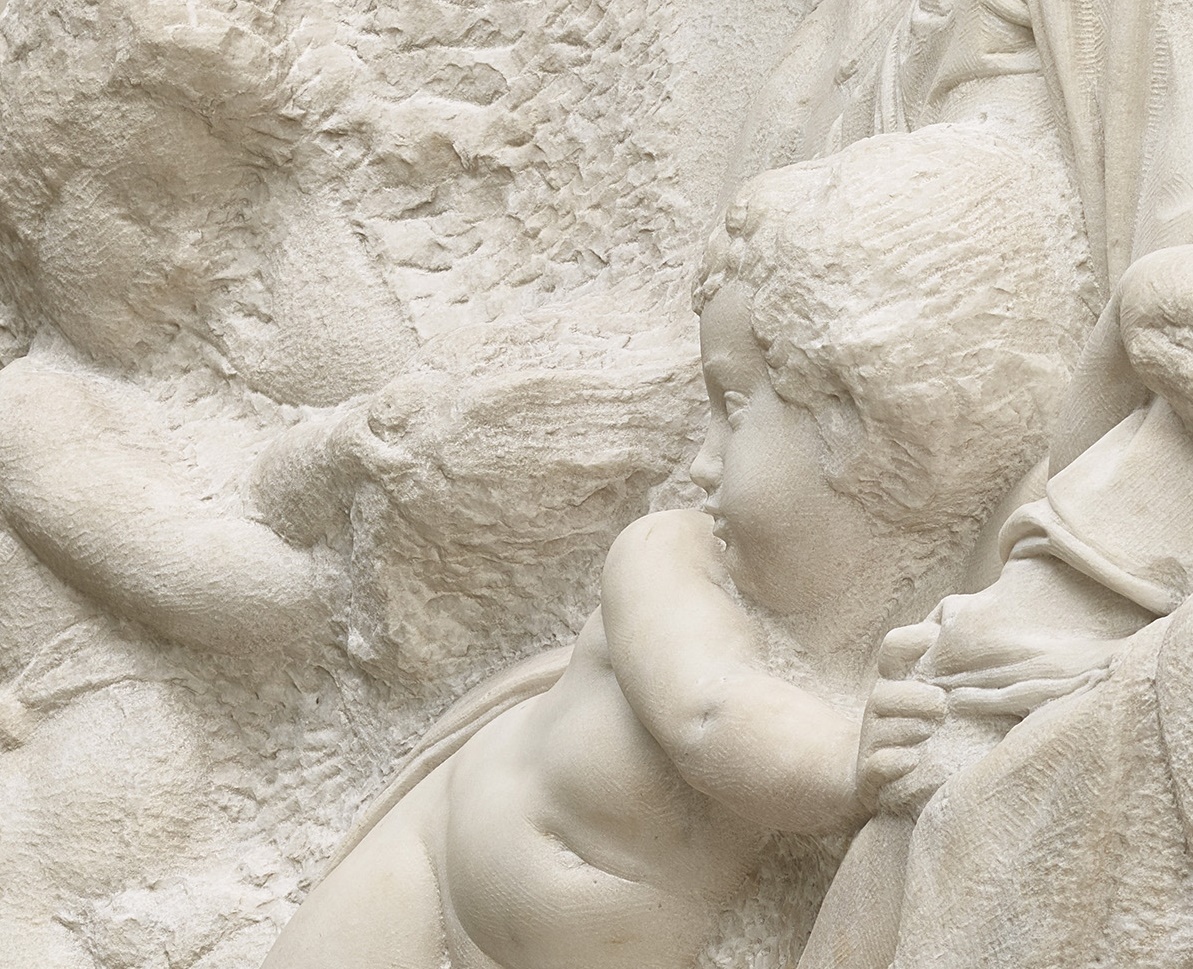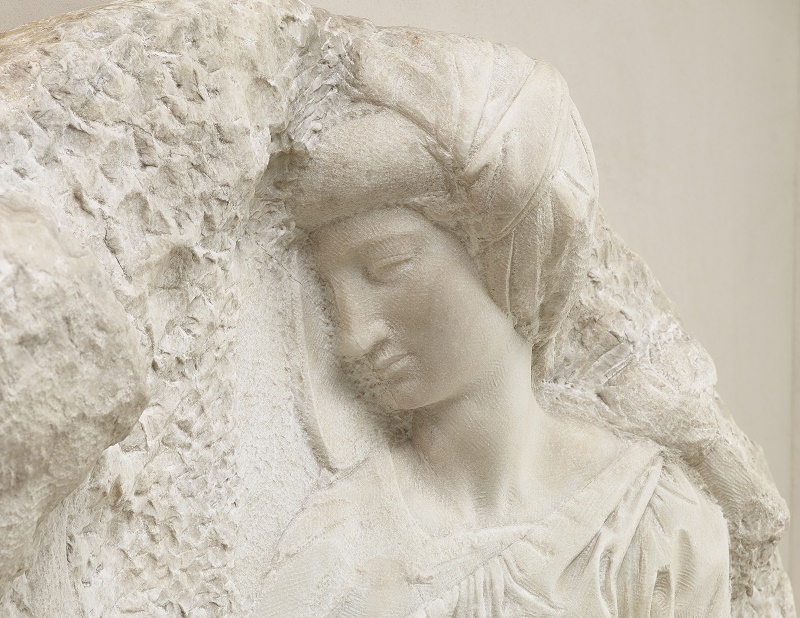Michelangelo's Madonna and Child | reviews, news & interviews
Michelangelo's Madonna and Child
Michelangelo's Madonna and Child
Why the Taddei Tondo, on loan to the National Gallery's Michelangelo & Sebastiano exhibition, makes the perfect Easter image

Michelangelo's Taddei tondo, which depicts the Madonna and Child with the Infant St John in a rocky landscape, is the only Michelangelo marble in Britain.
In this extract, I explain why this great sculptural relief packs such a powerful narrative punch, as well as exploring its meaning in relation to Christ's future destiny. The discussion focuses on the unusual poses of the two children: the chubby infant St John who holds out a fluttering bird, and the lithe Christ Child who dramatically recoils - almost flying out of the sculptural space - while looking sharply back over his shoulder.
What justifies such dramatic poses for the two children? A 14th-century Vita di San Giovanni Battista provided a lively iconographical source for such depictions. According to this account, which embellishes ancient Eastern sources, the Holy Family encountered the child-hermit John while passing through the desert on their way home from their Flight into Egypt (the meeting is an apocryphal invention).The children spend a day and a night together before John embarks on his life of strict penitence in the wilderness, leading eventually to his baptism of Christ and ultimately his martyrdom. In the Taddei Tondo, John wears the hermit’s leather girdle and camel-hair gown (his attire as an adult as described in the Gospels) with his baptismal bowl slung over his back. He holds out a bird to the Christ Child, who is startled, while his mother – her gentle, classical profile emphasised by the loop of her veil – holds out her hand, probably in a blessing or light caress. Her attitude contains memories of Leonardo’s Madonna of the Yarnwinder, exhibiting Michelangelo’s uncanny ability to recall and rotate figure poses as if they were three-dimensional models. Much has been made of the species of the bird, which is evocatively suggested through its roughly chiselled "flapping" wings. Is it a dove, or a goldfinch? And why is the Christ Child so alarmed by John’s actions? Most commentators agree that the bird is a goldfinch, which brings with it powerful intimations of Christ’s Passion. The goldfinch, which feeds on thistle thorns, is said to have removed a thorn from Christ’s brow at Calvary and to have been splashed with the Redeemer’s blood, so gaining its red face. The bird is thus a symbol of Christ's future sacrifice, while the child's dramatic attempt to flee embodies his very human fear of his adult destiny (paralleled later in his Agony in the Garden). Malcolm Easton has notably taken issue with such a reading, pointing out that no Florentine theological source from this date alludes to Christ’s fear of the Passion. He describes the Christ Child’s placid expression as one of mild and agreeable surprise. The goldfinch was also a favourite pet for children of the period, and its inclusion brings a human dimension to the biblical narrative with which parents and children could readily identify. It had been used prolifically in works from the 1400s onwards (usually clutched in the Christ Child’s fist) to make such devotional themes enjoyable and approachable.
Much has been made of the species of the bird, which is evocatively suggested through its roughly chiselled "flapping" wings. Is it a dove, or a goldfinch? And why is the Christ Child so alarmed by John’s actions? Most commentators agree that the bird is a goldfinch, which brings with it powerful intimations of Christ’s Passion. The goldfinch, which feeds on thistle thorns, is said to have removed a thorn from Christ’s brow at Calvary and to have been splashed with the Redeemer’s blood, so gaining its red face. The bird is thus a symbol of Christ's future sacrifice, while the child's dramatic attempt to flee embodies his very human fear of his adult destiny (paralleled later in his Agony in the Garden). Malcolm Easton has notably taken issue with such a reading, pointing out that no Florentine theological source from this date alludes to Christ’s fear of the Passion. He describes the Christ Child’s placid expression as one of mild and agreeable surprise. The goldfinch was also a favourite pet for children of the period, and its inclusion brings a human dimension to the biblical narrative with which parents and children could readily identify. It had been used prolifically in works from the 1400s onwards (usually clutched in the Christ Child’s fist) to make such devotional themes enjoyable and approachable. With Michelangelo, however, the idea seems to spring from the poignancy of the maternal theme and a very personal identification with the Christ Child’s humanity, a quality emphasised by the exposed genitals. This identification is also embodied in the child’s natural impulse to flee and seek the safety of his mother (who already seems a remote figure), while being simultaneously drawn towards his future, as one sketchy foot steps down to the ground.The human drama is further reinforced by the Baptist’s touching and somewhat clumsy offering of the bird to his playmate (which, like the Holy Spirit, flutters over Him). Rather than referring to a predominantly painted iconographical tradition of the Madonna and Child with a goldfinch, Michelangelo instead seems to be deliberately evoking the moving imagery of Greek funerary stelae (tombstones), in which deceased children hold or offer a bird, often in the form of a dove, symbolising the life-force or soul. A marble stele of a seated woman with a baby (a mother who perhaps died in childbirth) and a child holding out a bird shows the type of image that may have inspired the central motif of Michelangelo’s "invenzione antica", infusing it with its particular melancholy; Greek stelae, which in Michelangelo's day survived from ancient cemeteries, have also been noted as an inspiration for his earlier Madonna of the Stairs.
With Michelangelo, however, the idea seems to spring from the poignancy of the maternal theme and a very personal identification with the Christ Child’s humanity, a quality emphasised by the exposed genitals. This identification is also embodied in the child’s natural impulse to flee and seek the safety of his mother (who already seems a remote figure), while being simultaneously drawn towards his future, as one sketchy foot steps down to the ground.The human drama is further reinforced by the Baptist’s touching and somewhat clumsy offering of the bird to his playmate (which, like the Holy Spirit, flutters over Him). Rather than referring to a predominantly painted iconographical tradition of the Madonna and Child with a goldfinch, Michelangelo instead seems to be deliberately evoking the moving imagery of Greek funerary stelae (tombstones), in which deceased children hold or offer a bird, often in the form of a dove, symbolising the life-force or soul. A marble stele of a seated woman with a baby (a mother who perhaps died in childbirth) and a child holding out a bird shows the type of image that may have inspired the central motif of Michelangelo’s "invenzione antica", infusing it with its particular melancholy; Greek stelae, which in Michelangelo's day survived from ancient cemeteries, have also been noted as an inspiration for his earlier Madonna of the Stairs.
The power of sculpture, moreover, is that Michelangelo is freed from the descriptiveness of colour upon which the identification of the bird as a goldfinch largely depends. Its small smooth head, around which the heads of the three protagonists revolve, seems to hold different associations for each of them. For the joyful John – "allegrezza" in the 14th-century legend – it captures a sense of his chosen life in the wilderness; indeed, the legend mentions his casual handling of birds, large and small. In his grip, it more specifically evokes the turtledove, his symbolic attribute as Forerunner of Christ (John is the last Jewish prophet), celebrated in the Song of Solomon, and also in the hymn sung on his feast day in Florence; John’s arms are reverently crossed, allowing one hand to encircle the bird’s head, the other possibly its feet. For Mary and Christ, the bird also holds potent meaning, evoking sacrifice, the Holy Spirit, and more universally the captive human soul, which, as Redeemer, Christ will set free. The pensive Virgin, classically robed and turbaned like an ancient sibyl, seems imbued with the gift of prophecy. In the words of the Dominican preacher Girolamo Savonarola (whose "living voice" long reverberated in Michelangelo’s memory), "…do you suppose that [the Virgin] did not know the whole Passion of Christ step by step?"
The relief as a whole, with its passages of rough-hewn stone, evokes the rugged landscape of the desert, and simultaneously describes both the "rocky path" that John the Baptist took to prepare the way for the Messiah, and the Virgin’s humility (she sits on the ground). At the same time, the jutting slab at the base, which forms part of the crude frame, recalls the Stone of Unction (the slab that sealed Christ’s tomb) and Christ’s future Resurrection. But, above all, this shelf of stone reveals Michelangelo’s reluctance to obscure the original form of his marble block, ensuring that his circular scene has the transcendental power of a vision.
- Michelangelo Buonarroti: The Taddei Tondo by Alison Cole (Royal Academy Publications, £12.95)
- Read more First Person articles on theartsdesk
Explore topics
Share this article
Add comment
The future of Arts Journalism
You can stop theartsdesk.com closing!
We urgently need financing to survive. Our fundraising drive has thus far raised £49,000 but we need to reach £100,000 or we will be forced to close. Please contribute here: https://gofund.me/c3f6033d
And if you can forward this information to anyone who might assist, we’d be grateful.

Subscribe to theartsdesk.com
Thank you for continuing to read our work on theartsdesk.com. For unlimited access to every article in its entirety, including our archive of more than 15,000 pieces, we're asking for £5 per month or £40 per year. We feel it's a very good deal, and hope you do too.
To take a subscription now simply click here.
And if you're looking for that extra gift for a friend or family member, why not treat them to a theartsdesk.com gift subscription?

Comments
Wrong time of year, however